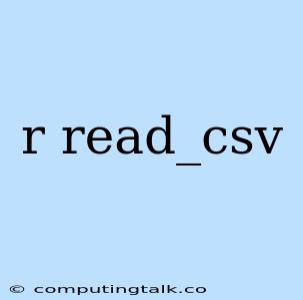The read_csv() function in the r programming language is an essential tool for data scientists and analysts who work with comma-separated value (CSV) files. This function provides a straightforward and efficient way to import data from CSV files into r data frames, making it readily accessible for analysis and manipulation.
Understanding the Basics of read_csv()
At its core, the read_csv() function serves as a bridge between CSV files and r data structures. It reads data from a specified CSV file and converts it into a data.frame, the standard data structure in r for representing tabular data. This data frame is then ready for you to perform various operations, such as statistical analysis, visualization, or machine learning.
How it Works:
-
File Path: You need to provide the path to your CSV file as an argument to the
read_csv()function. This path can be either a relative or absolute path depending on your file organization. -
Data Extraction: The function reads the CSV file line by line, interpreting each line as a row of data. It identifies the delimiter, which is typically a comma (
,) but can be customized. -
Column Interpretation: The
read_csv()function automatically detects the data types of each column based on the values it encounters. It can handle numeric, character, logical, and even date-time formats. -
Data Frame Creation: The extracted data is then organized into a
data.frame, where each row corresponds to a record in the CSV file and each column represents a specific attribute.
Practical Example: Reading a CSV File
Let's illustrate with an example:
# Load the readr package
library(readr)
# Assuming you have a CSV file named "data.csv" in your working directory
data <- read_csv("data.csv")
# View the first few rows of the data frame
head(data)
In this snippet:
- We first load the
readrpackage, which contains theread_csv()function. - We specify the file name
"data.csv". If the file is in a different directory, you would provide the full path. - The
read_csv()function reads the data and stores it in the variabledata. - Finally,
head(data)displays the first six rows of the data frame.
Customizing read_csv()
The read_csv() function offers numerous customization options for handling different scenarios:
1. Specifying Delimiters:
- If your CSV file uses a delimiter other than a comma, you can use the
delimargument to specify it:
data <- read_csv("data.csv", delim = ";") # If the delimiter is a semicolon
2. Handling Missing Values:
- By default,
read_csv()treats empty cells as missing values (represented asNAinr). You can control this behavior using thenaargument.
data <- read_csv("data.csv", na = c("NA", "N/A", ""))
3. Defining Column Types:
- If you want to override the automatic data type detection, you can use the
col_typesargument:
data <- read_csv("data.csv", col_types = cols(
column1 = col_character(), # Force 'column1' to be character
column2 = col_double(), # Force 'column2' to be numeric
column3 = col_date(format = "%Y-%m-%d") # Specify date format
))
4. Skipping Rows or Columns:
- You can skip specific rows or columns using the
skipandskip_empty_rowsarguments:
data <- read_csv("data.csv", skip = 5) # Skip the first five rows
data <- read_csv("data.csv", skip_empty_rows = TRUE)
Advanced Use Cases:
The read_csv() function goes beyond simple CSV file reading. It can handle complex scenarios like:
- Handling Quoted Text: The
quoteargument allows you to specify the character used for quoting text within your CSV file. - Encoding Support: The
localeargument enables you to specify the character encoding of your CSV file, making it compatible with various character sets. - Progress Indicator: The
progressargument provides visual feedback during the reading process, especially helpful for large files.
Conclusion:
The read_csv() function in r is a powerful tool for importing and working with data from CSV files. It offers versatility, customization, and efficiency, making it a cornerstone for data analysis tasks in r. By mastering the use of read_csv(), you can efficiently load and prepare data for analysis, visualization, and other operations in your r projects.
